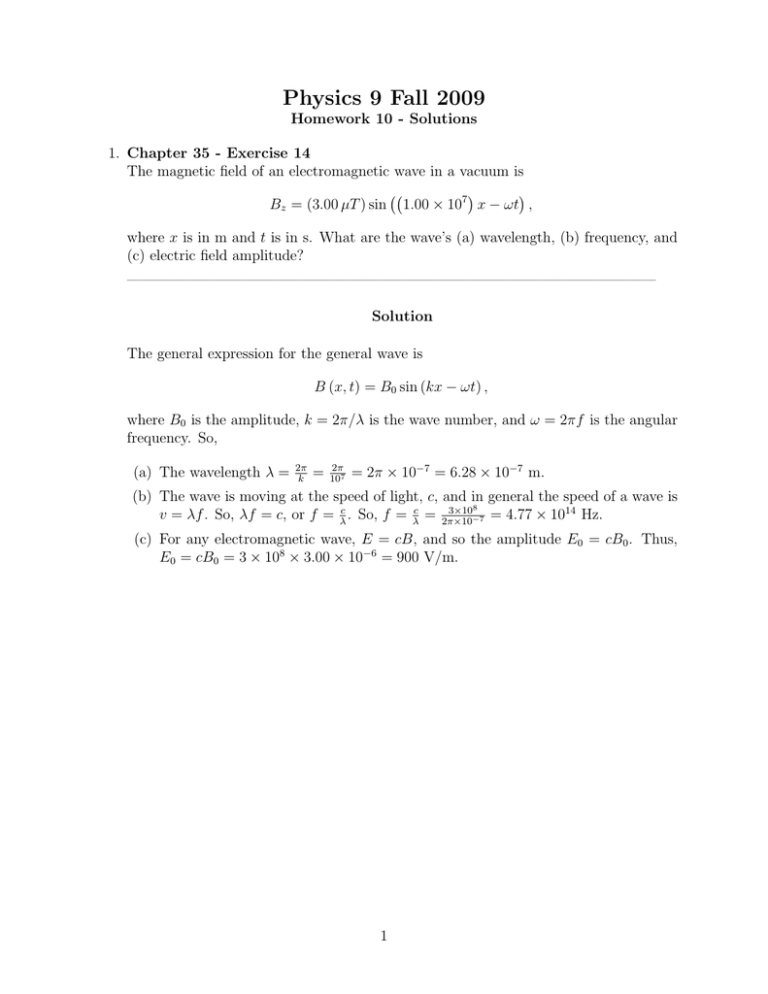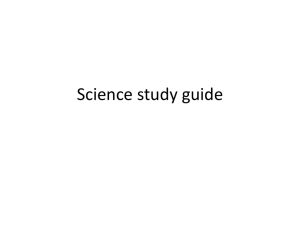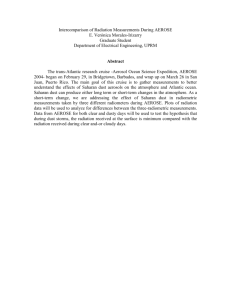Physics 9 Fall 2009
advertisement

Physics 9 Fall 2009 Homework 10 - Solutions 1. Chapter 35 - Exercise 14 The magnetic field of an electromagnetic wave in a vacuum is Bz = (3.00 µT ) sin 1.00 × 107 x − ωt , where x is in m and t is in s. What are the wave’s (a) wavelength, (b) frequency, and (c) electric field amplitude? ———————————————————————————————————— Solution The general expression for the general wave is B (x, t) = B0 sin (kx − ωt) , where B0 is the amplitude, k = 2π/λ is the wave number, and ω = 2πf is the angular frequency. So, (a) The wavelength λ = 2π k = 2π 107 = 2π × 10−7 = 6.28 × 10−7 m. (b) The wave is moving at the speed of light, c, and in general the speed of a wave is 3×108 14 Hz. v = λf . So, λf = c, or f = λc . So, f = λc = 2π×10 −7 = 4.77 × 10 (c) For any electromagnetic wave, E = cB, and so the amplitude E0 = cB0 . Thus, E0 = cB0 = 3 × 108 × 3.00 × 10−6 = 900 V/m. 1 2. Chapter 35 - Exercise 15 The electric field of an electromagnetic wave in a vacuum is Ey = (20.0V /m) cos 6.28 × 108 x − ωt , where x is in m and t is in s. What are the wave’s (a) wavelength, (b) frequency, and (c) magnetic field amplitude? ———————————————————————————————————— Solution Again, the general expression for the general wave is E (x, t) = E0 sin (kx − ωt) , where E0 is the amplitude, k = 2π/λ is the wave number, and ω = 2πf is the angular frequency. So, everything is defined as before. (a) The wavelength λ = 2π k = 2π 6.28×108 = 1.00 × 10−8 m. (b) The wave is moving at the speed of light, c, and in general the speed of a wave is 3×108 16 Hz. v = λf . So, λf = c, or f = λc . So, f = λc = 1.00×10 −8 = 3.00 × 10 (c) For any electromagnetic wave, E = cB, and so the amplitude B0 = E0 /c. Thus, 20 −8 B0 = Ec0 = 3×10 T. 8 = 6.67 × 10 2 3. Chapter 35 - Problem 30. What electric field strength and direction will allow the electron in the figure to pass through this region of space without being deflected? ———————————————————————————————————— Solution The magnetic force points down by the right-hand-rule (noting that the electron carries ~ has a negative charge). So, the applied electric field has to cancel this force, and so E to point downward, pulling the electron up. The force balances when FE = FM , or qE = qvB, which gives E = vB. Plugging in the numbers gives E = (2.0 × 107 ) (0.010) = 2.0×105 V/m, pointing down. 3 4. Chapter 35 - Problem 35. The magnetic field inside a 4.0 cm-diameter superconducting solenoid varies sinusoidally between 8.0 T and 12.0 T at a frequency of 10 Hz. (a) What is the maximum electric field strength at a point 1.5 cm from the solenoid axis? (b) What is the value of B the instant E reaches its maximum value? ———————————————————————————————————— Solution Faraday’s law says that Z d ~ · dA. ~ ~ B E · d~s = − dt For theHsolenoid, the electric field circles around inside the solenoid, so at a distance ~ · d~s = E (2πr) = − d (B (πr2 )), and so E = − r Ḃ. So, we just need B (t). r < R, E dt 2 I The field varies sinusoidally from 8 to 12 T, so the correct expression is B (t) = BC + B0 sin (2πf t) = 2 + 10 sin (20πt) , where BC is a constant magnetic field. (a) So, E = − 2r Ḃ, and taking the derivative gives Ḃ = 40π cos (20πt), and so E = −20πr cos (20πt) V/m, which has it’s maximum value when 20πt = π, 3π, · · · . In this case the cosine term is 1, and so Emax = 20πr V/m. So, at r = 1.5 cm, then Emax = 20π (0.015) = 0.94 V/m. (b) The electric field reaches a maximum when 20πt = π, 3π, 5π, · · · , for which the sine function is zero. So, when the electric field reaches it’s maximum, the B = BC + B0 sin (π) = BC , or B = 10 T. 4 5. Chapter 35 - Problem 37. A wire with conductivity σ carries current I. The current is increasing at the rate dI/dt. (a) Show that there is a displacement current in the wire equal to (0 /σ) (dI/dt). (b) Evaluate the displacement current for a copper wire in which the current is increasing at 1.0 × 106 A/s. ———————————————————————————————————— Solution (a) The displacement current is Idisp = 0 dΦdtE . Now, in general, I = JA, where J is the current density. But, we also know from Ohm’s law, that J = σE. So, I = JA = (σE) A = σ (EA). But, for this simple case, EA = ΦE is the electric flux. So, we have that I = σΦE . = σ dΦdtE . Comparing Now, taking the time derivative of this expression gives dI dt this to the definition for the displacement current we see that Idisp = 0 dI . σ dt (b) For copper, σ = 6.0 × 107 Ω−1 m−1 , and so Idisp = 0 dI 8.85 × 10−12 = 1.0 × 106 = 1.48 × 10−13 A. σ dt 6.0 × 107 5 6. Chapter 35 - Problem 51. The intensity of sunlight reaching the earth is 1360 W/m2 . Assuming that all the sunlight is absorbed, what is the radiation pressure force on the earth? Give your answer in newtons and as a fraction of the sun’s gravitational force on the earth. ———————————————————————————————————— Solution The total force on the earth is Frad = prad A, where prad is the radiation pressure, and 2 A is the cross-sectional area of the earth, A = πRE . Here, RE = 6400 km is the radius of the earth. Now, the radiation pressure is prad = Ic , where I is the intensity of the radiation. So, the total radiation force is 2 Ffrad = 2 π (6.4 × 106 ) 1360 πRE I = = 5.78 × 108 N. c 2.99 × 108 GmE M . Here This seems large, but let’s compare it to the gravitational force, Fg = 2 rE G = 6.672 × 10−11 is Newton’s gravitational constant, mE = 6 × 1024 kg is the mass of the earth, M = 2 × 1030 kg is the solar mass, and rE = 1.50 × 1011 m is the orbital radius of the earth. So, 2 2 rE I πRE Frad = 1.64 × 10−14 . = Fg GcmE M So, the radiation force is ≈ 10−14 times as large as the gravitational force. Of course, it makes sense that this force should be much weaker since we are in a stable orbit around the sun and aren’t being blown away by the radiation pressure. 6 7. Chapter 35 - Problem 52. A laser beam shines straight up onto a flat, black foil with a mass of 25 µg. What laser power is needed to levitate the foil? ———————————————————————————————————— Solution The foil will be balanced when the gravitational force is exactly canceled by the radiation pressure force, Fg = FR . Now, in terms of the radiation pressure, pR , we have FR = pR A = PAcA = Pc , where P is the power of the radiation source, and we recalled that pR = P/Ac. So, FR = Pc = mg = Fg , or P = mcg. Thus, P = mcg = 25 × 10−6 7 3 × 108 (9.8) = 73.5 W. 8. Chapter 35 - Problem 54. You’ve recently read about a chemical laser that generates a 20 cm-diameter, 25 MW laser beam. One day, after physics class, you start to wonder if you could use the radiation pressure from this laser beam to launch small payloads into orbit. To see if this might be feasible, you do a quick calculation of the acceleration of a 20 cmdiameter, 100 kg, perfectly absorbing block. What speed would such a block have if pushed horizontally 100 m along a frictionless track by such a laser? ———————————————————————————————————— Solution The radiation pressure creates a force on the block, FR = pR A, where A is the area of the beam. This produces an acceleration, a = FR /m = pRmA , and is constant. This acceleration leads to a final velocity vf2 = vi2 + 2a∆x, which says that √ vf = 2a∆x = r 2pR A∆x = m r 2P ∆x , mc since vi = 0, and we have replaced pR A = P/c, where P is the power of the laser. Plugging in the numbers gives s r 2P ∆x 2 (25 × 106 ) (100) = = 0.408 m/s, vf = mc 100 (3 × 108 ) which is pretty slow! This isn’t the best way to launch payloads! 8 9. Chapter 35 - Problem 55. An 80 kg astronaut has gone outside his space capsule to do some repair work. Unfortunately, he forgot to lock his safety tether in place, and he has drifted 5.0 m away from the capsule. Fortunately, he has a 1000 W portable laser with fresh batteries that will operate for 1.0 hr. His only chance is to accelerate himself toward the space capsule by firing the laser in the opposite direction. he has a 10 hr supply of oxygen. Can he make it? ———————————————————————————————————— Solution The laser produces a radiation force, FR = pR A = P/c, where P is the power of the P , but it only lasts for an laser. This produces a constant acceleration, a = FR /m = mc hour (the battery life of the laser). After this time, the astronaut will have picked up P P 2 a final velocity of vf = at = mc t, after having gone a distance x = 12 at2 = 2mc t . After this he will just coast along at the same constant velocity. Let’s see if he can make it. After the first hour, the astronaut is traveling at a speed of v= (1000) (3600) Pt = = 1.5 × 10−4 m/s, mc 80 × 3 × 108 and he has travelled a distance x= P 2 1000 t = (3600)2 = 0.270 m. 2mc 2 (80) (3 × 108 ) So, he still has to travel a distance 5 − 0.270 = 4.73 m, and he only has 9 hours left to do it. Can he make it? Coasting along at the speed v, to travel the remaining distance would take 4.73 distance = = 31, 533 s = 8.76 hours. t= speed 1.5 × 10−4 This time is just barely under the remaining 9 hours, so he can just make it! 9 10. Chapter 35 - Problem 60. Large quantities of dust should have been left behind after the creation of the solar system. Larger dust particles, comperable in size to soot and sand grains, are common. They creat shooting stars when the collide with the earth’s atmosphere. But very small dust particles are conspicuously absent. Astronmers believe that the very small dust particles have been blown out of the solar system by the sun. By comparing the forces on dust particles, determine the diameter of the smallest dust particles that can remain in the solar system over long periods of time. Assume that the dust particles are spherical, black, and have a density of 2000 kg/m3 . The sun emits electromagnetic radiation with power 3.9 × 1026 W. ———————————————————————————————————— Solution The sun gravitationally attracts the dust particles, while its radiation pressure pushes them away. In order for the dust to stay, Frad ≤ Fg . Now, the gravitational force is Gmdust M , where m is the mass of the dust particle, which we can write in F = g r2 dust terms of the density and radius as mdust = 43 πρR3 , and M is the solar mass. Thus, GM ρR3 F = 4π . g 3 r2 Now, the radiation force is given in terms of the radiation pressure and cross-sectional area of the dust particle as Frad = prad Adust = Ic πR2 . Here we have re-expressed the force in terms of the intensity of the radiation. The intensity is the power of the sun, P , divided by the area over which the power is spread out. This area is just a sphere P Rdust . with radius equal to the earth’s orbital radius, so A = 4πr2 . So, Frad = 4c r2 In order for the dust to stay in the solar system, Frad ≤ Fg , so P Rdust 4π GM ρR3 ≤ 3 r2 4c r2 or, upon solving for Rdust , we have Rdust ≥ 3P . 16πGM cρ With numbers, we have Rdust ≥ 3P 3 (3.9 × 1026 ) = = 2.93 × 10−7 m. 16πGM cρ 16π (6.67 × 10−11 ) (2 × 1030 ) (3 × 108 ) (2000) So, any particles bigger than 0.293 µm are more strongly attracted to the sun than they are repelled by the radiation pressure. Particles smaller than this will be pushed out of the solar system. So, if the biggest radius is 0.293 µm, then the biggest diameter is 0.585 µm. 10


